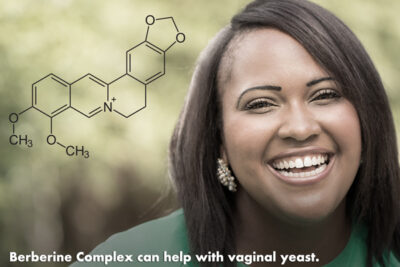For VAGINAL YEAST, berberine is an anti-candida remedy that discourages yeast from reproducing or flourishing. It also fosters the growth of helpful probiotics–the good bacteria–which further inhibits yeast overgrowth. Berberine is a potent remedy for vaginal yeast, impeding fungus, yeast, and protozoan pathogens by preventing their RNA functions and protein synthesis. Berberine is also an immune system booster that enhances white blood cell macrophage activity.
 Vaginal yeast is generally not an infection caused by a foreign microbe that invades from outside, as candida yeast and many other microbes naturally live in the vaginal canal. Usually vaginal yeast species stay quietly in the background, and co-exist harmoniously with other healthy microbes. Yeast only overgrows and causes symptoms if the environment is disturbed, if the ‘good’ microbial species that keep it in check are compromised, or if abnormal conditions over-stimulate it to reproduce. These conditions include stress, sleep deprivation, excess dietary sugar or alcohol, honeymoons and other fun times, poor immune function, and low-estrogen conditions that prevent the vaginal tissues from staying moist and supple.
Vaginal yeast is generally not an infection caused by a foreign microbe that invades from outside, as candida yeast and many other microbes naturally live in the vaginal canal. Usually vaginal yeast species stay quietly in the background, and co-exist harmoniously with other healthy microbes. Yeast only overgrows and causes symptoms if the environment is disturbed, if the ‘good’ microbial species that keep it in check are compromised, or if abnormal conditions over-stimulate it to reproduce. These conditions include stress, sleep deprivation, excess dietary sugar or alcohol, honeymoons and other fun times, poor immune function, and low-estrogen conditions that prevent the vaginal tissues from staying moist and supple.
Researchers in a 2010 study sought to investigate the antimycotic activity of berberine alone and in combination with antifungal azole drugs against a specific Candida albicans organism which creates a biofilm and demonstrates resistance to traditional antifungal agents. Their results showed that berberine inhibited the growth of several Candida species.1
Overall, berberine has excellent antiviral and antimicrobial action: it suppresses growth of Gram-positive and Gram-negative bacteria as well as yeast, proven in a 2003 study that looked into the in vitro antifungal activity of berberine isolated from its leaves, stems, and root.2
Berberine also bolsters whole-body immune function, because in the digestive tract berberine encourages good probiotic bacteria to flourish, and discourages yeast and noxious microbes. As well as boosting total immunity, it thus can also help gas, bloating, IBS, and diarrhea.
Berberine is a bitter-tasting, yellow plant alkaloid with a long history of medicinal use in Chinese and Ayurvedic medicine. Berberine is present in the roots, rhizomes and stem bark of various plants including goldenseal, golden rod, golden-thread, Oregon grape, and barberry. We prefer a highly potent extract that includes all or most of these active constituents to increase the amount of berberine per dose. This also brings the other supportive ingredients of each plant, such as hydrastine and canadine, into a synergistic blend to enhance the effect of berberine. In our practice, we’ve seen better results with a berberine blend for candidiasis than with one herb in isolation. Standardization of the concentrate ensures that each dose contains a consistent amount of active alkaloids. Many of our patients prefer berberine in a capsule concentrate because these herbs in liquid tinctures are bitter; they were historically used as yellow dye and can stain clothing if spilled.
Recommendation: Berberine 2 or 3 capsules providing total amounts: Barberry Root Extract 400 mg, Oregon Grape Root Extract 400 mg, Goldenseal Root and Rhizome Extract 100 mg, standardized to contain 5% total alkaloids including berberine. Take 2-3 times daily, or as directed by your healthcare provider. Like most herbs, it is best absorbed between meals.
References
- Wei, Guo-Xian, Xin Xu, and Christine D. Wu. “In vitro synergism between berberine and miconazole against planktonic and biofilm Candida cultures.” Archives of oral biology 56.6 (2011): 565-572.
- Freile, M. L., et al. “Antimicrobial activity of aqueous extracts and of berberine isolated from Berberis heterophylla.” Fitoterapia 74.7-8 (2003): 702-705.
- Iwu, Maurice W., Angela R. Duncan, and Chris O. Okunji. “New antimicrobials of plant origin.” Perspectives on new crops and new uses. ASHS Press, Alexandria, VA (1999): 457-462.
- Martins, Natália, et al. “Candidiasis: predisposing factors, prevention, diagnosis and alternative treatment.” Mycopathologia 177.5-6 (2014): 223-240.